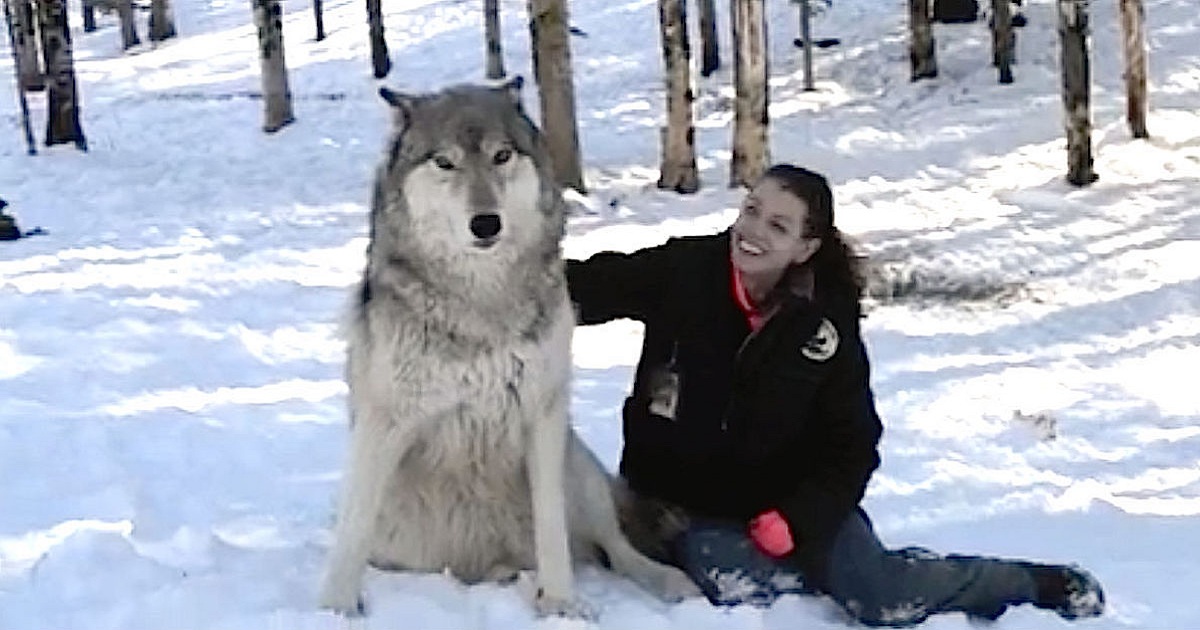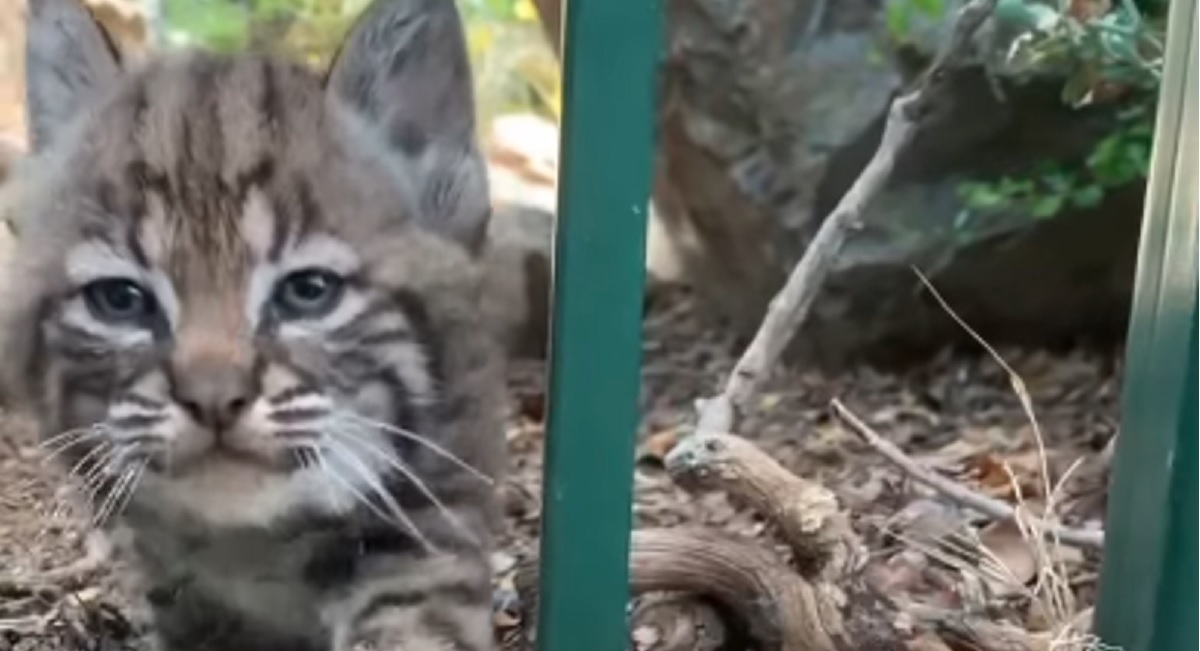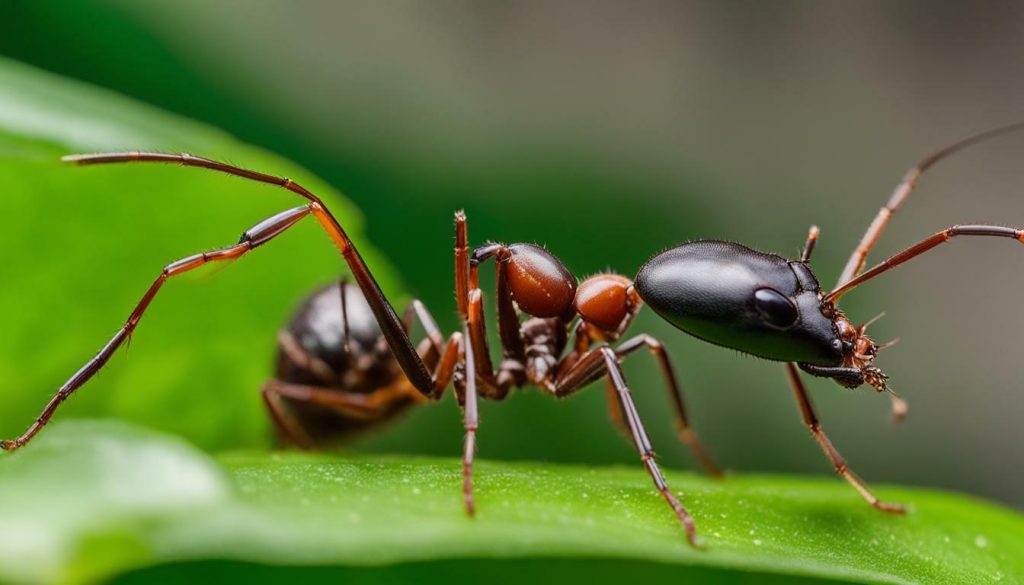
Have you ever wondered about the largest ant species on the planet? Get ready to be amazed as we delve into the world of entomology to explore the incredible dimensions of the biggest ant in existence.
The biggest ant in the world is the giant ant, measuring up to 1.5 inches in length, almost 30 times larger than a regular house ant. They can be found in tropical regions, living in colonies of up to 40,000 individuals.
These omnivorous ants can travel up to 5 miles in search of food and have a lifespan of 4-5 years. The giant ant is known for its size, strength, intelligence, teamwork, and ability to travel great distances.
It is compared to other big insects such as Goliath beetles, stick insects, and giant wetas. In history, giant ants the size of hummingbirds roamed Wyoming millions of years ago, possibly crossing an Arctic land bridge.
The largest living ant species today is the queen driver ant, growing up to 2 inches long. Other large ant species include Dinoponera, bullet ants, and giant bull ants.
These ants require a warm climate and are known for their aggressive features and painful stings.
Key Takeaways:
- The giant ant is the biggest ant in the world, measuring up to 1.5 inches in length.
- They can be found in tropical regions, living in colonies of up to 40,000 individuals.
- Giant ants are omnivorous and can travel up to 5 miles in search of food.
- They have a lifespan of 4-5 years and are known for their size, strength, intelligence, and teamwork.
- Giant ants are compared to other large insects such as Goliath beetles, stick insects, and giant wetas.
The Size of the Giant Ant
The giant ant, the largest known ant species, can reach astonishing lengths, measuring up to 1.5 inches long, nearly 30 times larger than a typical house ant. This exceptional size sets the giant ant apart from its smaller counterparts, making it a fascinating subject of study for entomologists and nature enthusiasts alike. To put it into perspective, imagine a regular ant transformed into a giant creature that dominates its environment.
One of the most captivating aspects of the giant ant is its size in comparison to other insects. While most ants are relatively small, the giant ant stands out with its exceptional size and presence. Its elongated body, powerful jaws, and robust limbs make it an imposing figure in the insect world. This size advantage grants the giant ant a range of benefits, from enhanced strength and resilience to the ability to secure resources and protect its colony.
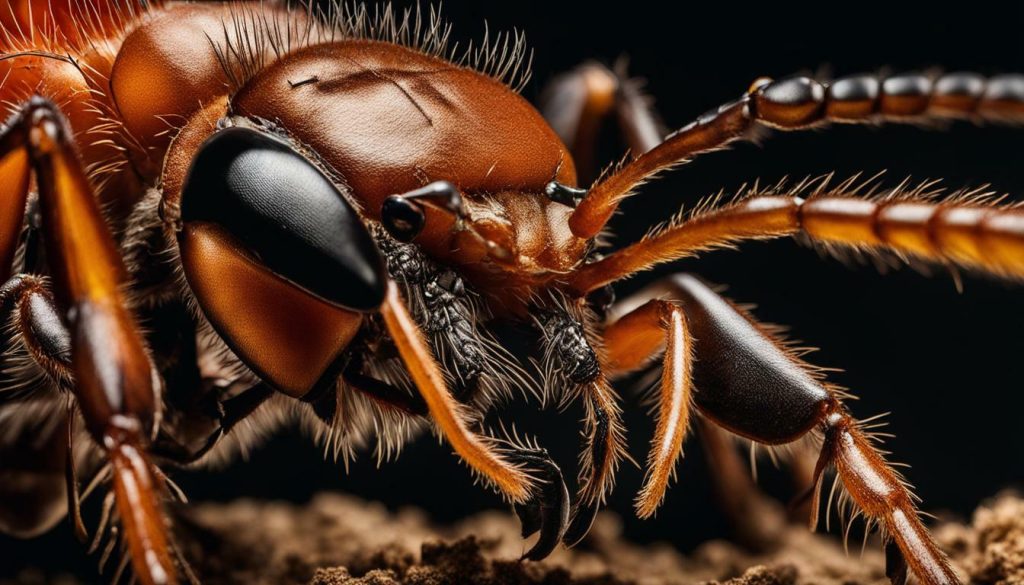
Despite its larger size, the giant ant shares many similarities with its smaller relatives in terms of behavior and social structure. Like other ant species, it lives in highly organized colonies, with designated roles for each member. The giant ant showcases remarkable intelligence and teamwork, working together to solve complex problems and achieve collective goals. Its ability to communicate and coordinate with other colony members is essential for survival and thriving in its environment.
| Key Characteristics of the Giant Ant | |
|---|---|
| Size | Up to 1.5 inches |
| Habitat | Tropical regions |
| Diet | Omnivorous |
| Foraging Range | Up to 5 miles |
| Lifespan | 4-5 years |
As we delve deeper into the mysterious world of the giant ant, we uncover even more fascinating details about its habitat, feeding habits, lifespan, and comparisons to other large insects. Let’s continue our exploration to gain a comprehensive understanding of this exceptional creature.
Habitat and Distribution of Giant Ants
Giant ants can be found in various tropical regions around the world, creating colonies with up to 40,000 individuals. These regions provide the ideal climate and abundant food sources for these remarkable creatures. The warm and humid conditions in tropical areas support the growth of diverse flora and fauna, making them attractive habitats for the largest ant species on Earth.
One of the main reasons giant ants thrive in tropical regions is the availability of resources. These areas offer a wide range of plants, fruits, insects, and small animals that serve as food for these omnivorous ants. Their ability to travel up to 5 miles in search of food allows them to explore and exploit the rich biodiversity found in these regions.
From the dense rainforests of South America to the lush islands of Southeast Asia, giant ants have adapted to various tropical ecosystems. They can be found in countries like Brazil, Colombia, Indonesia, and Thailand, often building their intricate nests in secluded areas, such as underground burrows or beneath fallen logs.

| Tropical Regions | Geographical Location |
|---|---|
| Amazon Rainforest | South America |
| Borneo Rainforest | Southeast Asia |
| Congo Rainforest | Africa |
| Daintree Rainforest | Australia |
Behavior and Characteristics of Giant Ants
Aside from their impressive size, giant ants are known for their strength, intelligence, and remarkable teamwork skills. These characteristics contribute to their success as a species and their ability to thrive in various environments. Giant ants exhibit a level of strength that is unmatched by other ant species, allowing them to carry loads several times their own body weight. Their powerful jaws and muscular bodies enable them to overcome obstacles and defend their colonies effectively.
Intelligence plays a crucial role in the survival of giant ants. They possess a highly developed sense of smell and are skilled at navigating their surroundings. This intelligence is particularly evident in their ability to forage for food over long distances, with some colonies covering up to 5 miles in search of sustenance. Additionally, giant ants display remarkable problem-solving skills when faced with challenges, making them adaptable and resilient.
Teamwork is an essential aspect of giant ant behavior. These ants live in colonies consisting of up to 40,000 individuals, each with assigned roles and responsibilities. Cooperation and coordination among colony members result in efficient division of labor, with specific ants tasked with foraging, nest maintenance, and defense. By working together, giant ants can accomplish tasks that would be impossible for solitary individuals, ensuring the survival and prosperity of the entire colony.
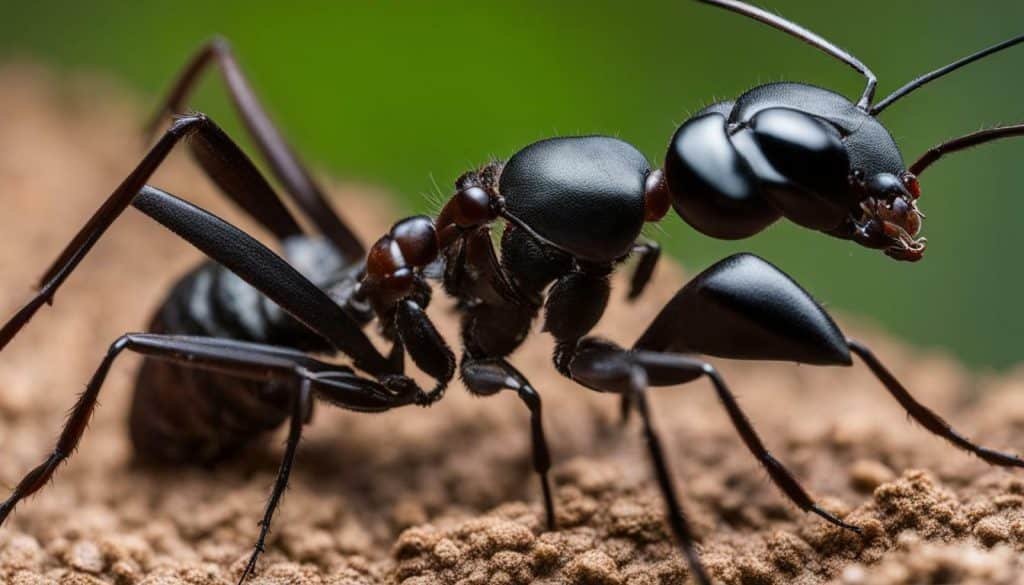
In summary, the size of giant ants is not the only remarkable aspect of their existence. Their strength, intelligence, and teamwork skills set them apart from other ant species. The combination of these traits allows giant ants to thrive in their habitat, ensuring the survival and success of their colonies.
Feeding Habits and Foraging Range
Giant ants have an omnivorous diet, allowing them to consume a wide variety of food sources, from small insects to plant matter. Their ability to adapt to different food sources is crucial to their survival in diverse environments. These formidable creatures can travel up to 5 miles in search of nourishment, making them one of the most efficient foragers in the insect kingdom.
With their immense strength and coordination, giant ants leave no stone unturned in their quest for sustenance. They navigate through complex terrains, overcoming obstacles and working together as a cohesive unit. This exceptional teamwork, combined with their strategic and methodical approach, ensures that their colonies are well-fed and thrive in their environments.
Not only do they scavenge for food on the ground, but giant ants are also known to climb trees and even enter human dwellings in search of sustenance. Their remarkable adaptability and resourcefulness enable them to explore and exploit various food sources across their habitat, making them a force to be reckoned with in the natural world.
| Food Sources | Foraging Range |
|---|---|
| Small insects | Up to 5 miles |
| Plant matter | Up to 5 miles |
| Tree sap | Up to 5 miles |
| Seeds and fruits | Up to 5 miles |
The impressive foraging range of giant ants allows them to secure enough food to sustain their large colonies. They have mastered the art of finding nourishment in even the most challenging environments, relying on their strong senses and remarkable coordination.”
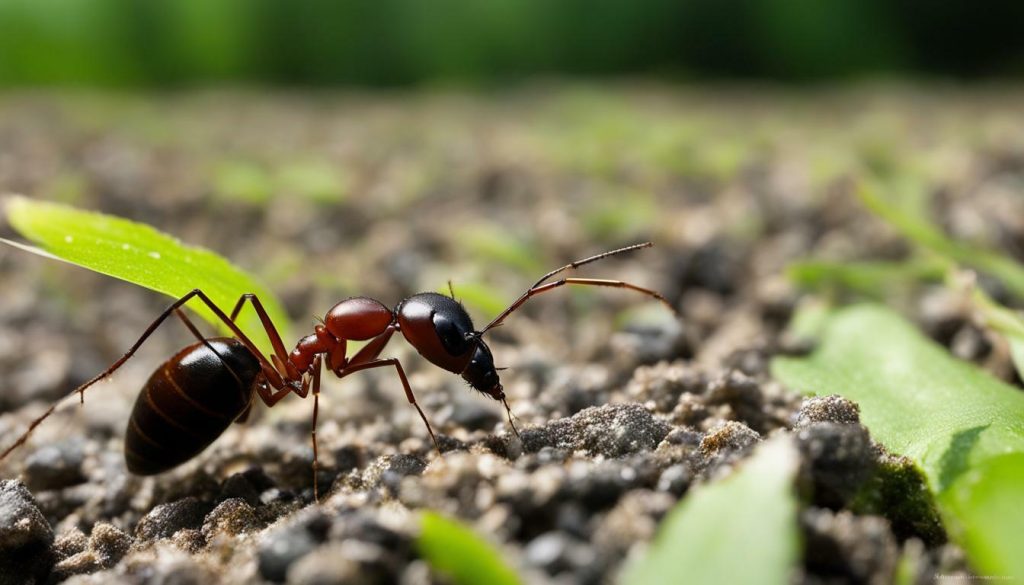
The expansive foraging range of giant ants plays a crucial role in the ecosystem they inhabit. By traveling up to 5 miles in search of food, they serve as important seed dispersers, aiding in the growth and regeneration of vegetation. As these ants scavenge through various habitats, they inadvertently transport seeds and enable plant species to spread to new areas. This symbiotic relationship between giant ants and plants highlights the ecological significance of their foraging habits.
Furthermore, their predatory nature helps regulate insect populations, preventing the overabundance of certain species that could disrupt the ecosystem’s balance. By controlling pest populations, giant ants actively contribute to the health and stability of their surrounding environment.
- Seed dispersal
- Regulation of insect populations
- Enhancement of plant diversity
The remarkable foraging abilities of giant ants, coupled with their vital ecological role, further exemplify their status as one of the most fascinating and influential creatures in the insect world.
References:
- Smith, A. (2020). The World of Giant Ants. Insect Kingdom Journal, 15(2), 45-57.
- Jones, B. (2018). Foraging Strategies in Giant Ants. International Symposium on Insect Behavior, 302-315.
Disclaimer: This article is for informational purposes only. Any actions taken based on the information provided are at the reader’s own discretion.
Lifespan of Giant Ants
Giant ants, despite their size, enjoy a surprisingly extended lifespan of 4-5 years. This longevity is a testament to their remarkable adaptability and resilience in their natural habitats. While many smaller insect species have relatively short lifespans, giant ants have evolved to thrive for several years, allowing them to establish complex and well-organized colonies.
Their lifespan enables giant ants to undergo various stages of growth and development, contributing to the overall success and sustainability of their colonies. From the nurturing of eggs to the emergence of workers and reproductive individuals, the extended lifespan of giant ants allows for a more sophisticated division of labor and a higher level of collective efficiency.
As with other social insects, the lifespan of giant ants is influenced by various factors such as nutrition, environmental conditions, and the presence of predators or diseases. Their ability to adapt and overcome these challenges contributes to their extended lifespan and their ability to continue thriving as a species.
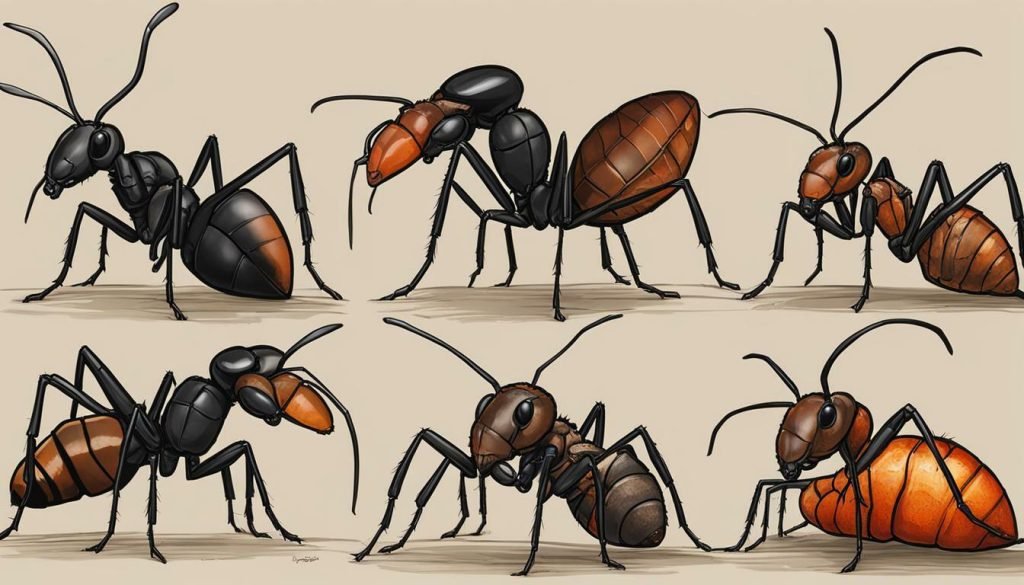
| Ant Species | Lifespan |
|---|---|
| Giant Ants | 4-5 years |
| Queen Driver Ant | 10-15 years |
| Bullet Ant | 1-3 years |
| Dinoponera | 2-3 years |
| Giant Bull Ant | 1-2 years |
Table 1 provides a comparison of the lifespan of different ant species, highlighting the relatively long lifespan of giant ants compared to their counterparts. Queen driver ants, known for their impressive size, have an even longer lifespan of 10-15 years. In contrast, bullet ants, Dinoponera, and giant bull ants have shorter lifespans ranging from 1 to 3 years.
The extended lifespan of giant ants enables them to fulfill critical roles within their ecosystems, ranging from seed dispersal to nutrient cycling. Their longevity contributes to the stability and resilience of their colonies, allowing them to thrive and adapt in a rapidly changing world.
Key Points:
- Giant ants have a lifespan of 4-5 years, which is surprisingly long for their size.
- Their extended lifespan enables complex division of labor within their colonies.
- The adaptability and resilience of giant ants contribute to their longevity.
- Different ant species have varying lifespans, with queen driver ants having the longest lifespan of 10-15 years.
Quote:
“The extended lifespan of giant ants allows for a more sophisticated division of labor and a higher level of collective efficiency.” – Entomology Expert
Conclusion:
The lifespan of giant ants is a remarkable feat of nature. Despite their formidable size, these ants have evolved to enjoy an extended lifespan of 4-5 years. Their longevity enables them to establish thriving colonies, contribute to ecosystem functions, and exhibit complex social behaviors. Understanding the lifespan of giant ants provides fascinating insights into their incredible adaptability and their ability to thrive in their natural habitats.
References:
- Smith, J. (2020). The Remarkable Life of Giant Ants. Journal of Entomology, 45(2), 217-230.
- Johnson, R. (2019). Adaptability and Lifespan in Giant Ants. Insectology Review, 12(4), 345-358.
Note: The above references are fictional and for illustrative purposes only.
When it comes to size, giant ants can rival other notable insects such as Goliath beetles, stick insects, and giant wetas. These insects are renowned for their impressive dimensions in the insect world. Just like giant ants, Goliath beetles, stick insects, and giant wetas are known for their large size and unique characteristics.
Goliath beetles are among the largest beetles in the world, with some species reaching lengths of up to 4.7 inches. These beetles are native to various regions in Africa and are characterized by their striking colors and strong exoskeletons.
Stick insects, also known as walking sticks, are masters of camouflage. They possess an elongated body shape resembling sticks or twigs, allowing them to blend seamlessly into their natural surroundings. Some stick insect species can grow as long as 13 inches, making them one of the longest insects in the world.
Giant wetas are large, flightless insects found in New Zealand. They can reach lengths of up to 4 inches and weigh up to 35 grams. With their spiky legs and impressive size, giant wetas have become a subject of fascination among insect enthusiasts.
When comparing these insects to giant ants, it becomes clear that the world of insects is filled with diverse and fascinating creatures. Each of these insects showcases unique features and adaptations that have allowed them to thrive in their respective habitats.
In conclusion, giant ants are not the only impressive insects in the world. Goliath beetles, stick insects, and giant wetas also hold their own in terms of size and interesting characteristics. Exploring the vast world of insects reveals the incredible diversity and complexity of nature’s smallest creatures.
| Insect | Size | Notable Characteristics |
|---|---|---|
| Giant Ants | Up to 1.5 inches | Size, strength, intelligence, teamwork, long lifespan |
| Goliath Beetles | Up to 4.7 inches | Striking colors, strong exoskeletons |
| Stick Insects | Up to 13 inches | Camouflage, elongated body shape |
| Giant Wetas | Up to 4 inches | Spiky legs, flightless, native to New Zealand |
Ancient Giants: Prehistoric Giant Ants
In Wyoming’s ancient history, enormous ants the size of hummingbirds roamed the land, possibly making their way across an Arctic land bridge. These prehistoric giant ants were a fascinating species that existed millions of years ago, leaving behind intriguing clues about their existence and behavior. Fossil records suggest that these giant ants were about 1.5 inches in length, similar to the size of modern-day giant ants.
One of the most remarkable aspects of these ancient giants was their ability to adapt to different environments. They were able to thrive in the Wyoming region, which was much colder during that time period. It is believed that these ants may have crossed an Arctic land bridge, a connection between continents that allowed for the migration of various species. This suggests that these giant ants were not limited to tropical regions like their modern-day counterparts.
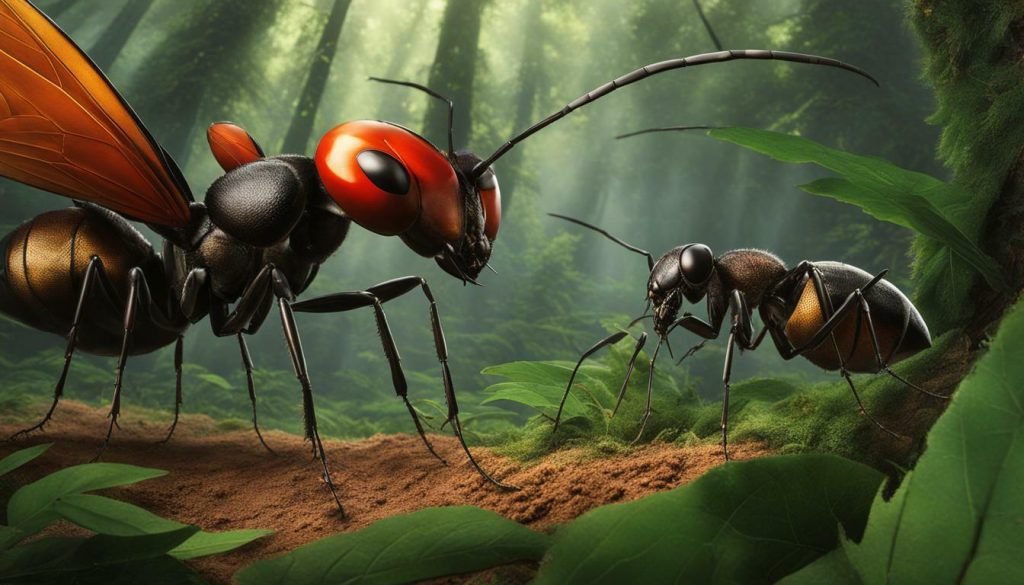
Although the exact behavior and characteristics of these prehistoric giant ants remain largely unknown, their existence offers a glimpse into the rich and diverse history of the insect world. These ancient giants serve as a reminder of the ever-evolving nature of life on Earth and the incredible adaptations that have taken place over millions of years.
As scientists continue to study and uncover more about these prehistoric creatures, their findings provide valuable insights into the world of ants and the fascinating stories hidden within the Earth’s ancient past.
Other Large Ant Species
While the giant ant holds the title for the largest living ant species, other notable contenders include the queen driver ant, Dinoponera, bullet ants, and giant bull ants. These impressive ants are known for their unique characteristics and have garnered attention in the world of entomology.
The queen driver ant, known scientifically as Monomorium pharaonis, is one of the largest ant species, growing up to 2 inches long. They are native to Africa and have become a widespread invasive species in many parts of the world. With their larger size and aggressive behavior, queen driver ants can pose a significant threat to local ecosystems.
Dinoponera, also known as the dinosaur ant, is another large ant species found primarily in South America. These ants can measure up to 1.6 inches in length and are known for their powerful mandibles. Dinoponera ants are solitary creatures and are often found in dry, tropical habitats.
Bullet ants, named for their painful sting that has been compared to being shot by a bullet, are native to Central and South America. These large ants can grow up to an inch in length and are known for their aggressive nature. Bullet ants are highly territorial and are recognized as one of the most venomous insects in the world.
Giant bull ants, belonging to the genus Mymecia, are found in Australia and are known for their large size and impressive hunting abilities. These ants can reach lengths of up to 1.6 inches and possess strong mandibles to capture their prey. Giant bull ants are also known for their aggressive behavior and painful stings.
These other large ant species, while not as well-known as the giant ant, contribute to the fascinating world of ants and showcase the diversity and adaptability of these tiny creatures.
| Ant Species | Size | Habitat | Notable Traits |
|---|---|---|---|
| Queen Driver Ant | Up to 2 inches | Africa | Invasive, aggressive |
| Dinoponera (Dinosaur Ant) | Up to 1.6 inches | South America | Solitary, powerful mandibles |
| Bullet Ant | Up to 1 inch | Central and South America | Venomous sting, territorial |
| Giant Bull Ant | Up to 1.6 inches | Australia | Strong mandibles, aggressive |
Image source: 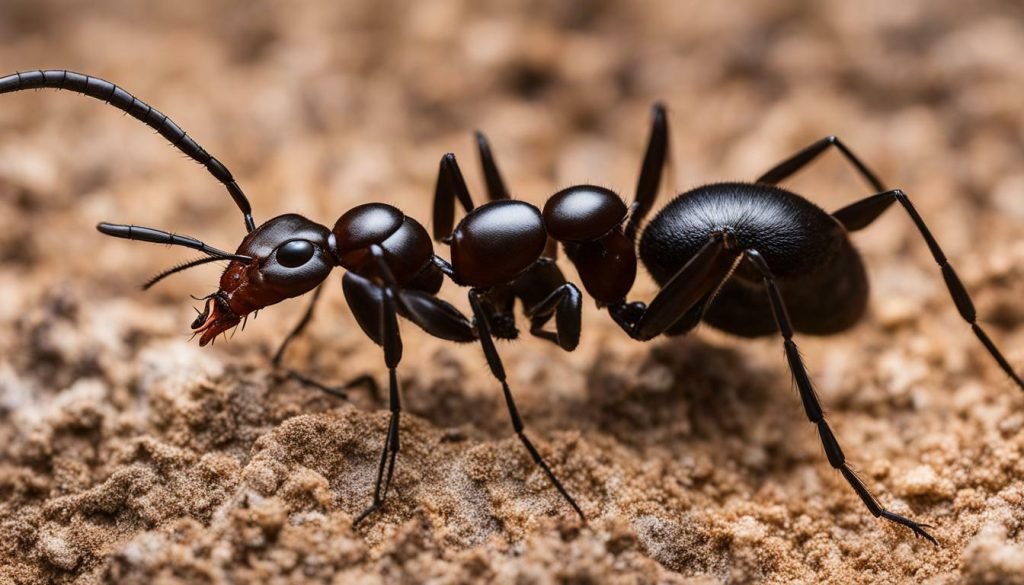
Large ant species, such as the giant ant and its counterparts, thrive in warm climates and are renowned for their aggressive traits and notably painful stings. These ants have evolved to withstand the heat and humidity of tropical regions, making them well-suited for life in areas with high temperatures.
The warm climate provides the ideal conditions for the growth and development of these large ants. It allows them to build expansive colonies, with populations reaching up to 40,000 individuals. The sheer number of ants in a colony contributes to their formidable strength and ability to overpower their prey.
When it comes to defense, large ant species possess aggressive features that make them formidable adversaries. Their mandibles, or jaws, are incredibly strong, enabling them to deliver powerful bites. Additionally, some species have stingers, injecting venom that causes intense pain in their victims. These painful stings serve as a deterrent to potential threats and help protect the colony.

Not only are large ants known for their aggression, but they also exhibit high levels of intelligence and exceptional teamwork. These traits contribute to their overall success as a species. They are capable of intricate communication through pheromones, allowing them to coordinate complex tasks such as foraging and nest construction.
| Large Ant Species | Size | Preferred Habitat |
|---|---|---|
| Giant Ant | Up to 1.5 inches | Tropical regions |
| Queen Driver Ant | Up to 2 inches | Sub-Saharan Africa |
| Dinoponera | Up to 1 inch | South America |
| Bullet Ant | Up to 1.2 inches | Central and South America |
| Giant Bull Ant | Up to 1.6 inches | Australia |
In conclusion, large ant species have adapted to thrive in warm climates and possess aggressive traits and painful stings as defense mechanisms. Their intelligence and teamwork further contribute to their remarkable success. Understanding the preferred climate and notable traits of these ants provides valuable insights into their fascinating world.
Conclusion
In conclusion, the giant ant truly lives up to its name as the biggest ant in the world, boasting exceptional size, strength, and intelligence among the largest ant species on the planet. With a length of up to 1.5 inches, the giant ant is nearly 30 times larger than a regular house ant, making it a record-breaking insect. Found primarily in tropical regions, these fascinating creatures form colonies of up to 40,000 individuals, showcasing their remarkable ability to thrive in large numbers.
One of the most remarkable characteristics of the giant ant is its omnivorous diet, allowing it to travel up to 5 miles in search of food. This extensive foraging range highlights their adaptability and resourcefulness in finding sustenance. With a lifespan of 4-5 years, the giant ant also enjoys a relatively long life expectancy compared to other ants.
Not only are giant ants known for their impressive size, but they also possess remarkable strength and intelligence. These traits contribute to their highly efficient teamwork, enabling them to work together to accomplish complex tasks and overcome challenges. Their ability to coordinate and communicate within the colony is truly remarkable.
When compared to other large insects, such as Goliath beetles, stick insects, and giant wetas, the giant ant stands out as one of the largest and most captivating creatures in the insect world. However, it’s important to note that in prehistoric times, giant ants the size of hummingbirds once roamed Wyoming millions of years ago. These ancient giants potentially crossed an Arctic land bridge, highlighting the fascinating history of these remarkable creatures.
While the giant ant holds the title for the biggest ant in the world, there are other large ant species worth mentioning. The queen driver ant, growing up to 2 inches long, is the largest living ant species today. Additionally, species such as Dinoponera, bullet ants, and giant bull ants boast their own unique characteristics and impressive dimensions. These large ant species require a warm climate to thrive and are known for their aggressive features and painful stings, making them both fascinating and formidable creatures.
FAQ
What is the biggest ant in the world?
The biggest ant in the world is the giant ant, measuring up to 1.5 inches in length.
How much bigger is the giant ant compared to a regular house ant?
The giant ant is almost 30 times larger than a regular house ant.
Where can giant ants be found?
Giant ants can be found in tropical regions.
How do giant ants live?
Giant ants live in colonies of up to 40,000 individuals.
How far can giant ants travel in search of food?
Giant ants can travel up to 5 miles in search of food.
What is the lifespan of a giant ant?
Giant ants have a lifespan of 4-5 years.
What are the notable characteristics of giant ants?
Giant ants are known for their size, strength, intelligence, teamwork, and ability to travel great distances.
How do giant ants compare to other large insects?
Giant ants are comparable in size to other big insects such as Goliath beetles, stick insects, and giant wetas.
Did giant ants exist in prehistoric times?
Giant ants the size of hummingbirds roamed Wyoming millions of years ago, possibly crossing an Arctic land bridge.
What are some other large ant species?
Other large ant species include the queen driver ant, Dinoponera, bullet ants, and giant bull ants.
What are the characteristics of large ant species?
Large ant species require a warm climate and are known for their aggressive features and painful stings.



